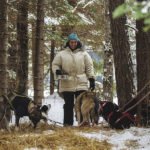It began in a sugar maple grove along the North Shore with a knife, an axe and a saw. I was trying to wrest my living from this northern landscape, and in spite of my inexperience, I could see that wood would be central to the endeavor. I needed to build a cabin to shelter me through the long winter. Billets of birch and maple cut, split and stacked to heat the cabin. A pole and a paddle to push my canoe through wild rice beds and up secret creeks where mallards and northern pike dwell. A spoon to stir the soup pot and a spile to tap the sugar maple trees. As I looked around at the land I had come to call home, it gradually became clear that everything depended upon wood the land in the form of trees and forests.
My early efforts in woodworking were clumsy and crude. I admired the native craftsmen and early European trappers who could build a canoe, a cabin, a pair of snowshoes and a sled with only a few basic tools, and I tried to model my woodworking on their example. But these are skills long in the learning, and with my axe, saw and crooked knife, I made a great many items whose eventual resting place was the wood stove. I longed after the sinuous curves and colorful, rich grain of the finished craft items I had seen, and wondered at the seeming ease with which an accomplished craftsman could free a paddle, spoon, or a bowl from a log. Frustration was my constant companion in those early days, when determination and experimentation were all that I had.
Determination and experimentation worked their magic over a period of years. Befriending and learning from many very talented craftspeople played an invaluable role, as well. As I made more shavings, my tools got sharper, my hands more certain, my eyes more observant. I learned to bend the ribs and planks of wooden boats, to cut joinery in furniture and cabinet work, to select trees for riving and trees for sawing. Slowly, I learned the properties and habits of birch, aspen, maple, oak, spruce, fir and pine, and to recognize their grain in a finished piece. I came to understand how skill and understanding builds upon itself. Wooden pieces that once seemed mysterious and daunting became comprehensible.
Slowly, cautiously, I began to teach some of what I had learned; first in informal settings to interested friends, then at annual craft gatherings, and eventually at several of the wonderful folk schools in the Upper Midwest. It’s a privilege to be able to pass on some of what I have learned and to observe that learning process taking root in new, aspiring woodworkers. There is a necessary trepidation in learning something completely new, perhaps more so in woodworking. The tools are razor sharp and will cut flesh and bone as easily as the wood they’re intended for, and it is bewildering how one slip of the hand can make the difference between a finished piece and firewood. Still, there always seem to be bold new woodworkers willing to study the secrets of the axe, the knife and the chisel. And to see uncertainty and unease become confidence and inspiration is an encouraging sight indeed.
I see myself and my early efforts so clearly in the students I teach. Challenge, frustration, failure, persistence and eventual success. And I believe firmly that the spirit of determination and experimentation (as well as a healthy sense of humor) are more critical to learning the skills of fine woodworking than any other factor.
As my understanding of wood and trees and forests has grown, my sense of appreciation and wonder has only deepened. The potential contained in a single tree is astounding—from fine musical instruments, to boats, barns and houses, tables and chairs, and spoons and bowls. Wood as a material is abundant, uniquely workable, and incredibly strong, light and beautiful. Each individual piece tells the story of its life as a tree, seasons of sweet soil and ample rain, and years of drought and bitter gravel. The story is always unfolding and whatever skill I may gain in this craft, I know that there will always be much more to learn and discover. Our region is blessed with vast forests, and the woods therein contain possibility yet unimagined.
By Kerry Lambertson



